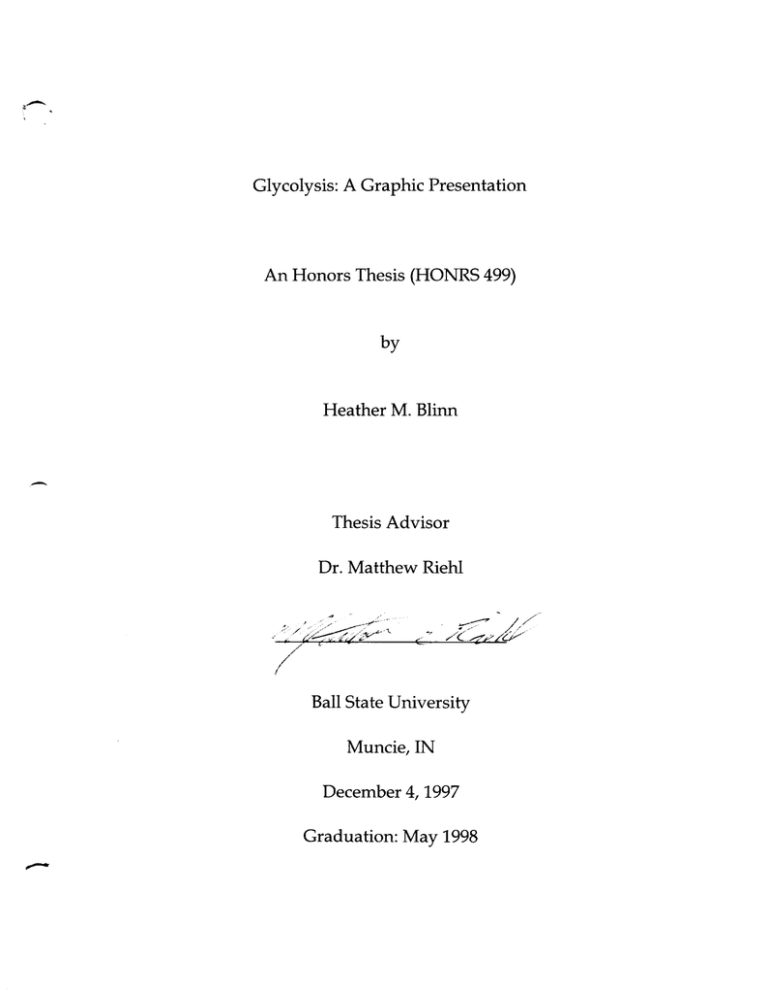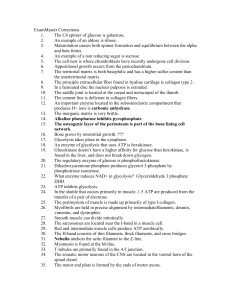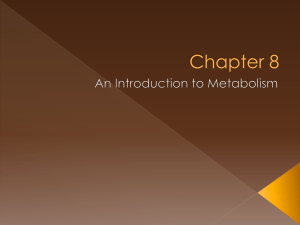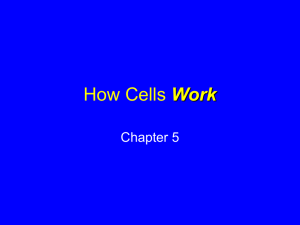-
advertisement

Glycolysis: A Graphic Presentation An Honors Thesis (HONRS 499) by Heather M. Blinn Thesis Advisor Dr. Matthew Riehl Ball State University Muncie, IN December 4, 1997 Graduation: May 1998 'SfC-, !\ -, he:.: IS L-!;> - :Y-!'Zn It, I :';'/ Purpose of Thesis This presentation is designed to make visible the process of glycolysis. Emphasis is placed on enzyme structure, changes in substrate structure and energy levels, and enzymatic control. The use of the process of glycolysis as a model metabolic pathway is also discussed. The object of the presentation is to educate the audience in biochemical concepts such as enzymatic catalysis, enzyme control, and the importance of glycolysis in everyday cellular life. - - Page 2 (read from slide) Why study glycolysis? Because every cell in your body uses this method to get the energy it needs, as well as other molecules it requires for cell function. (click screen, showing graphic) In addition, glycolysis is a good example of a metabolic pathway. By studying glycolysis, we can get a good general idea of how many multistep pathways in our body works. - -.. - Slide 3 Glycolysis is a 10-step energy-releasing pathway. One enzyme catalyzes each step. Why so many steps? Because glycolysis, the breaking down of glucose, does release a good bit of energy. If it were released all at once, the cell would have a much harder time capturing it into usable forms, such as ATP energy. Also, the cell has to "set up" the reaction - (click). In fact, half of glycolysis involves this setting up, and the second half spent reaping the rewards. (click) Glycolysis is also exquisitely controlled in order to neither fall short of nor overshoot the energy needs of the cell. - - Slide 4 Before we really start, let's go back and talk about ATP energy for a moment. (click on ATP). ATP is a relatively simple molecule (return while speaking until end phosphate group turns yellow) which the cell uses as a mobile energy carrier. This molecule is considered "high energy" because of the strain on the third phosphate subunit (return). Each of the three phosphate subunits carries a negative electrical charge. Since similar charges repel each other, the third phosphate is practically bursting at the seams to get away from the other negative charges. When this is allowed to occur in cellular processes, energy is released as the phosphate group flies off - energy which the cell can use to its own ends. (return twice) Left to its own devices is a molecule of ADP, which can be recharged by the cell by forcing another phosphate group on it. - - The first step of the Energy Investment phase is to change the structure of glucose by adding a phosphate to glucose, changing it to glucose-6-phosphate. To do this, the cell has to use ATP energy. One phosphate attaches to glucose, and the molecule that remains is the low-energy adenosine diphosphate (ADP). (click on lightening) This is the enzyme that catalyzes this reaction, phosphoglucokinase. An enzyme is a long chain of amino acids, (return) which often arrange themselves in sub-structures called alpha helixes and beta-pleated sheets.(return) Here is the protein in spacefill mode - this probably comes the closest to what the protein actually looks like. (Return) The molecule an enzyme acts upon is called its substrate - in this case, glucose. (return) The place on an enzyme where a reaction happens is often a cleft or hole and is called the active site. (return) Here's a good look at glucose occupying the active site. (return twice, pause, then click on X) Because A TP energy is invested in this step, the cell is quite interested in controlling it. It does so by what is called product inhibition - if the rest of the path shuts down, glucose-6-phosphate builds up and turns off the enzyme, so that glucose is not unnecessarily used. In the active pathway, glucose-6phosphate goes on to be acted upon by another enzyme. - Slide 5 This step shows the changing of glucose-6-phosphate to fructose-6-phosphate by the enzyme phosphofructoisomerase. This step is significant because we have changed from a six-member ring to a five-member ring. The cell does not have to expend energy to accomplish this - the double headed arrow shows that this step is reversible, not permanent, as is the first reaction. For this reason, there is no direct control over this enzyme - the cell controls the reaction by controlling the amounts of product and reactant in the cell. In the active pathway, the cell makes this reaction go forward by constantly using up the product in the third step. - Slide 6 Here see the cell investing another molecule of ATP energy, changing fructose6-phosphate to fructrose-l,6-bisphosphate. The enzyme, phosphofructokinase, (click on star) is composed of four identical subunits here we see two of them (return). These are two identical chains, each with an active site (return, return), and each binding a molecule of substrate (return until yellow color changes, pause, then one more) This enzyme, abbreviated pfk, is the most tightly controlled in the pathway, which makes sense, as it is fairly early on and involves the use of ATP energy. (return) Because of these controls, it is very sensitive to the energy state of the cell, becoming most fully active when energy requirements are high, and slowing down when the cell is resting. To see the advantage of this, the best analogy I can think of is the Sorcerer's Apprentice, which illustrates what a mess things can become when you leave something on overdrive. Some compounds that indicate an excess of energy in the cell and slow down this enzyme down are excess A TP and citrate, which is a byproduct of another method of energy production. In addition, the cell makes an inhibitor especially for this enzyme, fructose-2,6-bisphosphate, which is only produced when the cell is using too much energy. Some activators for this enzyme are thallium ions (return) a trace element in our systems, as well as other positive ions such as potassium. An important activator that binds at an allosteric site (return) is adenosine monophosphate, which is generally indicative of low cellular energy levels (return). (return) Here is the enzyme in all four subunits (return twice). Consider, when fully activated, this enzyme runs through four substrates at once at thousands of reactions a minute - hundreds per second. .- Slide 7 This reaction, which splits fructose-l,6-bisphosphate into two three-carbon molecules by the enzyme aldolase, is extremely important as there are very few reactions within the cell that break a bond between two carbons. The two products, dihydroxy acetone phosphate and glyceraldehyde-3-phosphate, each carry a phosphate group. - - Slide 8 It would be pretty inconvenient for the cell to have to create two sets of enzymes to deal with the two products of step four, so here it changes the DHAP into glyceraldehyde-3-phosphate. As can be seen by the arrow, this reaction is reversible, and the cell controls the reaction much as it does reaction number two, by controlling the amounts of reactant and product. This is generally done by immediately using the g-3-p in the next reaction, causing the equilibrium here to shift to the right according to Le Chatelier's Principle. - - Slide 9 Here we have the first step of the Energy Generation Phase. It is important to realize that this reaction happens twice for each molecule of glucose that runs through the pathway. In this reaction the enzyme glyceraldehyde dehydrogenase oxidizes a carbon, releasing energy by taking away a hydrogen atom and replacing it with an oxygen from a phosphate molecule. The molecule NAD+ captures the released energy when it accepts the hydrogen, becoming NADH, which is another important energy carrier within the cell. Since there are actually two molecules of glyceraldehyde from the original glucose molecule, two molecules of NADH are produced. - - - - - Slide 10 In this step, the phosphate group that we just attached to our molecule is now donated to a molecule of ADP to make ATP. Since this reaction runs twice, the cell has now made two A TP and recovered all the energy it invested in the first part of glycolysis. (click on bolt) (return three times) Here is the newly formed phosphoglycerate shown complexed with the newly formedATP. (While speaking, return three times) The yellow phosphate group is the one just transferred from the substrate. (return, return) Here you can see the substrate and A TP snugly fitting into the active site. (return- the rotation will take a few seconds) (return) Slide 11 The cell uses the next two steps to set up the final step in glycolysis. First, in this reaction, the enzyme phosphoglycerate mutase moves the phosphate group to the middle carbon, leaving an alcohol (OH) group on carbon three. - - - Slide 12 Second, the enzyme enolase dehydrates the molecule, removing the alcohol group from carbon three and the hydrogen from carbon two to form water. The new molecule, phosphoenol pyruvate, now has a double bond between carbons two and three. This is a very unstable molecule which really "wants" to change, rather like the third phosphate on ATP wants to come off. - - - Slide 13 This instability makes it relatively easy for the cell to use the remammg phosphate to make a high-energy molecule of ATP. The enzyme pyruvate dehydrogenase also adds water back to the molecule to form pyruvate. (click on star) This picture shows pyruvate, a rather small molecule, and two ions important in the reaction. The first, smaller green ion, is Manganese and required as a cofacter to the enzyme for the reaction to take place. The large pink atom is Potassium, which binds to an allosteric site near the active site. It acts as an activator to the enzyme. (click off enzyme) IS Overall, this step produces two ATP and two pyruvate, and since the cell has already paid back the energy invested in the first five steps, (click to next slide) - Slide 14 We find that overall, we now have 2 NADH, 2 ATP, and 2 pyruvate molecules. In all oxygen-using organisms, these pyruvate enter another series of reactions, oxidative phosphorylation, which produces even more ATP energy for the cell. - ~ u .~ ~ ~ (J,) ...c ~ 0 0 ~ ~ ~ ~ .~ (J,) . ...c u ~ (J,) ~ ~ rfJ rfJ s:: ~ ~ 0 ~ 0 .- .0 ~ ~ rfJ ~ s:: (J,) E bJ) ""0 (J,) ....... ~ 0 s:: ~ u <r: rfJ ~ (J,) ~ ~ ~ (J,) bJ) ;> 0 ~ 0 ~ s:: u 0 ~ (J,)"" rfJ ~ ;::::l 0 u >. ~ rfJ .~ s (J,) ~ u 0 .~ .- .- ""0 ~ ~ (J,)"" .- E ~ bI) s:: ...c u ro (J,) ~ ""0 ...c s:: ro ....... ....... (J,)"" ro ~ (J,) ~ ~ ~ ~ ....... ...c (J,) .-E s:: .-~ .......ro ~ Q 0 ~ ~ rfJ . ~ 8s::""...c(J,) E (J,) .-ro V) ~ ~ ~ rfJ ~ ~ ro s:: 0 rfJ .~ ~ ~ ro ~ . ~ ~ (J,) ;> .~ (J,) u ~ 0 u s:: (J,) (J,) ~ ~ (J,) ;> (J,) s:: (J,) ;> ro ~ Q ""0 ....... 0 ~ rfJ ~ 0 ~ ....c ~ s:: ro ~ >. ~ ro ~ rfJ ~ ~ - References 1. Bryant, T. N., H. c:. Watson, and P. L. Wendell. 1974. Structure of Yeast Phosphoglycerate Kinase. Nature, 247: 14-17. 2. Larson, Todd M., Timothy Laughlin, Hazel M. Holden, Ivan Rayment, and George H. Reed. 1994. Structure of Rabbit Muscle Pyruvate Kinase Complexed with Mn, K, and Pyruvate. Biochemistry, 33:6301-6309. 3. Perkins, Richard E., Stephen C. Conroy, Bryan Dunbar, Linda A. Fothergill, Michael F. Tuite, Mclz.nie]. Dobson, Susan M. Kingsman, and Alan]. Kingsman. 1983. The complete amino acid dequence of yeast phosphoglycerate kinase. Biochem. Journal, 211: 199-218. 4. Villeret, Vincent, Shengua Huang, Herbert]. Fromm, and William N. Lipscomb. 1995. Crystallographic Evidence for the action of potassium, thallium, and litium ions on fructose-l,6-bisphosphatase. Proc. Natl. Acad. Sci, USA, 92:8916-8920. - - Computer Programs Used: Isis Draw was used for all substrates, which were then copied into the program Accumodel which minimized the energy structures into three dimensions. The structures were then copied back into Isis Draw, which then converted the structures into Rasmol 3D images. All proteins were downloaded from the World Wide Web site: http://molbio.info.nih.gov/cgi-bin/pdb This site is a National Institute of Health site called "Molecules R Us". It contains all of the proteins from the Brookhaven Protein Database in a form which can be downloaded as Rasmol. The structures of ATP and ADP were downloaded from http://www.ibc.wustl.edulklothol.asite which contains many small organic molecules which can be downloaded in Rasmol form. - -






